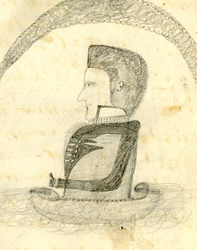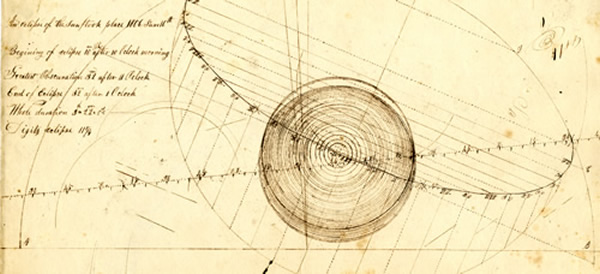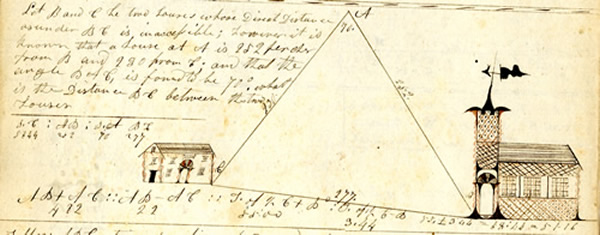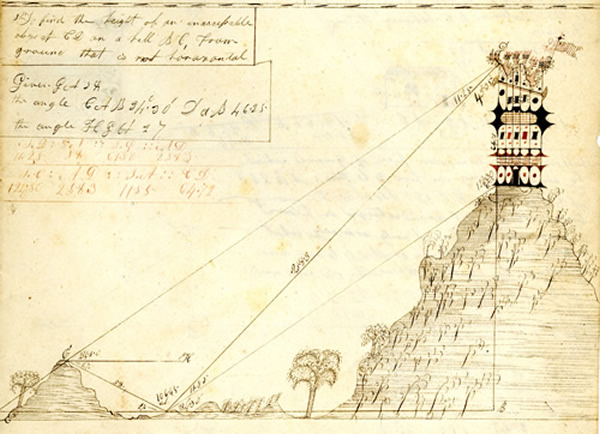Athelstan W. Smith, M.D.
Introduction

 Athelstan Washington Smith was an 1836 graduate of the Berkshire Medical Institution in Pittsfield, Mass. The material in this modest manuscript collection can be divided into three categories: papers generated prior to A.W. Smith’s entry into medical school; lecture notes taken while a medical student; and miscellaneous material dating from the year after his graduation. The papers in this collection were purchased for the Rare Books & Manuscripts Section of the Edward G. Miner Library in November 2015. The collection is contained in a single box of twenty-one folders.
Athelstan Washington Smith was an 1836 graduate of the Berkshire Medical Institution in Pittsfield, Mass. The material in this modest manuscript collection can be divided into three categories: papers generated prior to A.W. Smith’s entry into medical school; lecture notes taken while a medical student; and miscellaneous material dating from the year after his graduation. The papers in this collection were purchased for the Rare Books & Manuscripts Section of the Edward G. Miner Library in November 2015. The collection is contained in a single box of twenty-one folders.
At the time of his entry into medical school, Smith resided, presumably with his family, in Granville, Washington County, New York. The eastern terminus of the Village of Granville is on New State State’s border with Vermont. The earliest material in the collection is dated 1829, when Smith was a student at Granville High School. A pinned quire of folded leaves titled “Division of Land” (Folder 1) contains handwritten notes and diagrams on procedures for land surveying. The quire is dated May 1829 and may represent Smith’s class notes on this subject. At the end of this quire of notes are algebraic equations “executed by A.W.S. of Granville High School,” and a crude half-figure pencil drawing of a young male – perhaps a self-portrait – also dated 1829.
Smith had a strong interest in mathematics, which translated not only into carefully transcribed notes on surveying, but also on astronomy. Smith’s pre-medical school notes include detailed calculations and diagrams for solar and lunar eclipses (Folder 5), some of which may actually have been calculated before 1829, as well as two slender lecture notebooks (“Arithmetical Progression” and “Algebra”) that appear to have been copied at the Manchester Seminary (Manchester, Vermont?) in June 1834 (Folder 4).
The following year found Smith enrolled at the Vermont Academy of Medicine, later known as Castleton Medical College, in Castleton, Vt., a village just north of Granville across the Vermont border. Smith must have taken at least one course of lectures at the Vermont Academy of Medicine in the fall term of 1835. There are several sets of notes from lectures delivered at the Vermont Academy of Medicine by William Tully and Theodore Woodward in the fall of 1835 (Folders 7-10). One of these Castleton notebooks, “Notes from the medical lectures at Castleton, Vermont,, Fall term of 1835” (Folder 8), also includes on its final two leaves a table and diagram dated “Pittsfield [Mass.] Sept. 1836,” indicating Smith’s presence at the Berkshire Medical Institution in Pittsfield that year. A stitched quire containing notes of Tully’s fall 1835 lectures (Folder 9) concludes with a section titled “Professor Parkers Lectures Notes [sic].” Willard Parker taught surgery and physiology at the Berkshire Medical Institution in the mid-1830s.
To add to the confusion, Smith prepared for submission a graduation thesis (on hepatitis) to the “Vermont Medical College” dated “Woodstock. [Vt.?] Ma. 27. 1836” (Folder 12). That thesis may not actually have been submitted to the Vermont Academy of Medicine, but was certainly copied and submitted for his graduation from the Berkshire Medical Institution, Pittsfield, Mass., in December 1836. A.W. Smith, Granville, N.Y., is listed as a “senior” in the 1836 Catalogue of the trustees, faculty and students, of the Berkshire Medical Institution. He is listed as a graduate of that medical school in the Boston medical & surgical journal, 1836, 15:307 (with a thesis on hepatitis), as well as in the Catalogue of the officers and students of the Berkshire Medical Institution, for the year 1846 (Albany, N.Y., 1846). He is not listed among the 1836 graduates of the Catalogue of the officers and students of the Vermont Academy of Medicine, at Castleton. Autumnal term 1837 (Castleton, Vt., 1837).

An example of A.W. Smith's calculations for eclipses of the sun
Nineteenth-century American physicians were not always able to make a living by the practice of medicine alone – especially those who practiced in small towns and rural areas. In addition to treating patients, some physicians farmed, some were apothecaries, and some ran stores or other kinds of businesses. It would appear that A.W. Smith taught school for a period after his graduation from medical school. The collection includes a handwritten document titled “The School list for 1837 & 8” (Folder 13) that is annotated “Commenced November 13th, 1837” and “Closed March 12th 1838.”
Smith’s continued interest in astronomy is evidenced by a collection of calculations for eclipse of the sun for the years 1854-1875 (Folder 15), one of which uses “Scottsburgh, N.Y.” as the meridian. This was probably present-day Scottsburg in Livingston County, a crossroads in the western part of New York State. That Smith continued to practice medicine seems to be indicated in a letter he received from the Cincinnati-based eclectic physician and author John King (1813-1893). It is addressed to A.W. Smith, Scottsburgh, N.Y., is dated July 18, 1859, and responds to an inquiry from Smith regarding the availability of medical books that King has written (Folder 18).
A collection of miscellaneous documents (Folder 21) provides few clues regarding Smith’s occupations and whereabouts post-1859. A two-leaf accounting sheet dated June 15, 1869-March 23, 1870 details the sale or purchase of large amounts of comestibles (sugar, molasses, coffee, cod fish, currants, crackers, etc.) and items such as kerosene, starch, etc., suggesting that Smith operated a general store at this period. Receipts for payment dated 1873 and 1874 indicate that Smith was still alive in the mid-1870s. A detailed receipt to Mrs. A.W. Smith for the sale of furniture (dated April 20, 1878) may indicate the breakup of the Smith household after her husband’s decease. Receipts dated 1880 to Charles F. Smith and 1881 to Malinda J. Smith may provide the names of two of the children of Athelstan Washington Smith, M.D.

An example of calculating distances
Inventory of the papers of A. W. Smith, M.D.
- Folder 1: Division of Land (1829)
- Folder 2: Application of Algebra to Geometry (undated)
- Folder 3: Questions for Exercise [on Surveying] (undated)
- Folder 4: Arithmetical Progression [and] Algebra (Manchester Seminary, June 1834)
- Folder 5: [Solar and lunar eclipses] (calculated between 1829 and 1834?)
- Folder 6: Construction of a horizontal sun dial (undated)
- Folder 7: Prof. Tully’s Materia Medica [two small notebooks in paper wrappers] (Fall 1835)
- Folder 8: Notes from the Medical Lectures at Castleton, Vt. Fall Term of 1835
- Folder 9: Doctor Tully’s Lectures on Rhus (1835?) [and] Professors Parkers Lectures Notes (1836?)
- Folder 10: Notes from Prof. Tully’s Treatment of Diseases (1835?)
- Folder 11: [Two small quires of lectures notes] (undated)
- Folder 12: [Graduation thesis on hepatitis] (Woodstock. [Vt.?] Ma. 27. 1836)
- Folder 13: The School List for 1837 & 8. A.W. Smith
- Folder 14: [Lecture to an unnamed “Lyceum” on the “motion of the earth” (undated)
- Folder 15: Solar eclipses, 1852-1875 (calculated 185?)
- Folder 16: Moon epochs (calculated for the years 1861-1900)
- Folder 17: The American Indians. Extract (1844?)
- Folder 18: Letter from John King, M.D., Cincinnati, July 18, 1859
- Folder 19: The Scholars Repository, Vol. 1, No. 1. Decem. 9, 1859 [in-house school magazine?]
- Folder 20: Assessment Roll Dist. No. 5 (no indication of place or date)
- Folder 21: Miscellaneous receipts, 1869-1881

An example of calculating heights